
bolewts58
-
Posts
599 -
Joined
-
Last visited
-
Days Won
9
Content Type
Profiles
Forums
Blogs
Gallery
Events
Store
Posts posted by bolewts58
-
-
9 hours ago, elbavaro said:
Pictures from the back available?
I don't like the ribbon - looks new to me. The cross itself: well .... it looks like the ,odern copies, but ... not 100% sure.
Agree. Very likely a modern copy. This cross is widely faked. There are very few originals around. Better pictures including of the reverse and close-ups of the cross edge and enamel would confirm this one way or the other.
0 -
-
-
These 3 Freikorps awards are not difficult to find. There are several available on various dealer sites. A Silesian Eagle I cl. such as this type would be around 125 EUR, a Brigade Grodno Badge about 500 EUR and a von Loewenfeld Cross I cl. about 300 EUR. if you're serious about wanting these, I can help make suggestions for you.
0 -
These are indeed terrible fakes. But, there are also high quality die struck fakes of these three awards.
The Silesian Eagle is a common cast fake identified by those strange elongated box rivets.
Likewise, the Brigade Grodno badge and Loewenfeld Cross have been faked in great numbers and even in very believable high quality over the last 10 years or so.
It really is about educating yourself, rather than merely asking for people's opinions. The fakers of even the high-end die struck copies have made several easy to spot mistakes in creating their dies, if you know what to look for. If you want to collect Freikorps awards and badges, you should get yourself some good reference books. There are certainly some good ones around these days.
This is one of the best and widely available.
0 -
Very nice examples of the MGSS badge with the typical Freikorps black cloth backing. I've been looking for one of these for some time. They are hard to find.
0 -
1 minute ago, CRBeery said:
Thank you sir! It has the oak leaf and acorn motif of so many Freikorps pieces but then again it’s a German thing.
True. But, many Weimar ear German State Police units used oakleaves as collar insignia. Bavarian police used 2 different types. I would also suggest that it could be for forestry personnel.
0 -
Not a known Freikorps insignia. It could be a police collar badge or just for a hunting association.
0 -
1 hour ago, Deruelle said:
Many thanks to all. Is it easy to find such items now ?
Christophe
No. These pins are all quite scarce and very expensive. The pin you started this thread with would likely be at least 500 - 600 EUR and probably more if you could even find one.
0 -
Eric is correct.
Here is the history of this organization.
Der Reichsverband der Baltikumkämpfer
Organization for Freikorps veterans of the 1919 Baltic Campaigns, 1921-1936.
Founded as the Verein Ehemaliger Baltenkämpfer (Association of Former Baltic Fighters) in Magdeburg in 1921. In 1924, it was renamed Der Reichsverband der Baltikumkämpfer and in 1935, it merged with the short-lived Kameradschaft Baltikum und Freikorpskämpfer (founded in 1933) as essentially their memberships overlapped. On June 2-3, 1934 a reunion of the 36,000 members was held at Castle Saaleck where a large limestone plaque honoring the fallen of the Baltic campaign was installed in the east tower with a speech from the former Baltic commander, Graf Rüdiger von der Goltz. The association was disbanded in June 1936 by Interior Minister Wilhelm Frick.Here are membership documents and a membership pin for Verein Ehemaliger Baltenkämpfer and Der Reichsverband der Baltikumkämpfer.
Here are two other pins that likely have some association with this group. One is a pin for former members of the Eiserne Division and the other for Kameradschaft Freikorpskämpfer Gotha, an organization I don't have any specific information about.
0 -
Very nice. The mailed arm with sword inside the wreath shown on the stamp was worn as a silver collar badge by Freikorps Hübner. While the pass doesn't specifically indicate it, Freikorps Hübner took part in the Battles of Dachau on April 18, 1919 and Munich from April 30 - May 2, 1919.
0 -
Looking at the enamel I am pretty sure it is in fact cold acrylic enamel rather the fired glass enamel used on period originals. This explains the high, plastic-looking gloss, darker color red and uneven enamel build-up.
0 -
6 hours ago, Ulsterman said:
nice. Does that have a makers’ mark?
No. Very few Silesian Eagles have maker's marks.
0 -
-
1 hour ago, Chris Boonzaier said:
I agree... a non combattant Silesian Eagle 1st class is as rare as hens teeth...
I had a long correspondence with the guy who did the articles about the award for the BDOS... he said it was technically only allowed for the 2nd class to be awarded. There are a tiny amount of exceptions... almost singel figures.
I have a group with white ribbon EK2, Yellow ribbon Braunscheig, and eagles 1st and 2nd class to a non combattant (and a bunch of other awards)... rare as hell... but on the flip side... noone appretiates them
Agree grossly under-appreciated. What makes these even more unusual is being signed in pencil by two leading Reichswehr generals commanding in upper Silesia. Most of this particular type of document even for military personnel have facsimile signatures.
0 -
11 hours ago, Eric Stahlhut said:
actually, there could be a good chance of finding out, since he was a teacher. if you are so inclined you could contact the muzeum w Rybniku
Thank you for the suggestion.
0 -
2 hours ago, Eric Stahlhut said:
I wonder what Erich Salzbrunn did during the great war...many of those civilians (former soldiers) helped secure weapons from depots and distribute ammunition. perhaps that has something to do with his award level
That's a good point. It's possible he was a veteran and I only managed to get two of his award documents which does happen. But, also, he may have always just been a teacher and already too old to serve in 1914 when the war started. He could have been involved in what you suggest or could have been an Einwohnerwehr leader in Rybik. There's no way of knowing.
0 -
Eric. That's a very nice looking period SA II.
Here are a pair of documents to a teacher, Lehrer Herrn Erich Salzbrunn from Paruschowitz in Kreis Rybnik, Upper Silesia. Rybnik was the center of the the First Polish Uprising in 1919 and of the Upper Silesia plebiscite in March 1921.
The documents have been trimmed a bit. But, otherwise they're in good condition. The interesting thing about them is that they are both signed in pencil by well-known Reichswehr generals. The Silesia Eagle was awarded a lot to civilians who worked in some capacity with the Reichswehr in Grenzschutz Ost Schlesien. Most only got the 2nd class. So, it's unusual for a civilian to get the 1st class, as well. He must have been a pretty important civilian to warrant having his documents personally signed by a general. Most of this type of document have only facsimile or auto-pen signatures.
SA 2 doc is signed by Generalmajor Karl Hoefer (https://de.wikipedia.org/wiki/Karl_Hoefer) when he was commander of Reichswehr-Brigade 6 in Breslau, Oberschlesien. (https://www.axishistory.com/various/140-germany-reichswehr/reichswehr/2361-reichswehr-brigade-6)SA1 doc is signed by Generalmajor and Kommandeur der 2 Kavallerie-Division Otto von Preinitzer (https://de.wikipedia.org/wiki/Otto_von_Preinitzer), (https://de.linkfang.org/wiki/Otto_von_Preinitzer)0 -
I figured out WBK. Wehrmacht Bezirks Kommando.
0 -
Hi Dave
Thanks so much. This is outstanding and much more than I expected. Much appreciated.
What is WBK?
Brian
0 -
1 hour ago, Chris Boonzaier said:
Thanks,
yes indeed... the FK epp had a whole company of offcers serving as other ranks in the Zeitfreiwilligen... the Zeitfreiwillige were part time FK members... my wifes great grandfather was a Zeitfreiwillige in Leipzig, they were mainly ex young officers, students in the Univ and part time FK members
Here you go, Chris. Zeitfreiwillige Leipzig collar badges from my collection.
0 -
Here are three from my collection. The green colored piping (gold for officers) on a black diamond was added after September 30, 1919 to denote those who had originally volunteered for Freikorps Epp in March 1919. This acted as a Tradition Badge when Bayerisches Schützenkorps (Freikorps Epp)/Reichswehr Brigade 21 merged with Reichswehr Brigade 22 to become Reichswehr Brigade 21 of the Übergangsheer in October 1919. It continued to be worn as a Tradition badge in the Wehrmacht up to 1945.
The other types of badges on blue were worn as a Tradition badge by former temporary volunteers (Zeitfreiwillige) of Freikorps Epp (as noted above) on the uniform of the SA from 11/7/1933 and the Bavarian State Police from 16/10/1933. Authorizations for wear were issued up until 1939. However, the badge was allowed for wear until 1945.
The first one on plain black velvet belonged to Unteroffizier Wilhelm Förch. I have a few pictures of him as well as his Militärpass. As he is still wearing the badge without piping in the picture below, it was taken sometime between June 30, when Bayerisches Schützenkorps (Freikorps Epp) became Reichswehr Brigade 21 and September 30, 1919 when it merged with Reichswehr Brigade 22 to form the new Reichswehr Brigade 21 in the Übergangsheer.
There is a good article (Das Ärmelabzeichen "Freikorps Epp") by Jörg Bender in the January-April 1919 edition of the magazine Militaria & Phaleristik which contains pictures of the first two of the above badges. It gives a very detailed breakdown on the long history of this badge.
0 -
I have a document set to a WWI/Reichswehr Oberleutnant and would kindly like to ask for help from those with the appropriate research sources, what (if any) other awards he received.
His name is Oberleutnant Kurt Karies. He entered the 6th (1st West Prussian) Grenadiers "Count Kleist von Nollendorf” on 20/4/1912 as a Fahnrich and was promoted to Leutnant on 20/11/1913. He served with Grenadier Regiment 6. all through WWI and into the Freikorps period before joining Reichswehr Schützen Regt. 9. in July 1919 and the Sicherheitspolizei Berlin in June 1920. He was discharged due to the armed forces reductions in August 1920 as an Oberleutnant a.D.
His awards listed on his 1933 service record are: 8/10/1914 EKII, 4/1917 EKI, 19/9/1919 Silesian Eagle 1 and 2. Not listed in 1933 is: 25/6/1919 Probation Badge for the V Armeekorps (a Freikorps award).
He was wounded twice: 30/9/1914 and 15/7/1918. So, among other things, I wonder why he didn't get a black wound badge. Did he receive any other awards not listed?
I've attached both sides of the 1933 service record for reference.
Any help would be very much appreciated. Thanks.
 0
0 -
20 hours ago, CRBeery said:
Great to see your armband. I have seen three different ones. Mine, ones like yours with the typical ribbon colors of the Wurttemburg Civil verdienstorden and one with the colors of the Wurttemburg crown orders. As mine is one the tri color band would it be one of the last ones made? Is yours numbered? Thanks!
I don't know how to date the different armbands exactly, other than knowing the one I posted was used 1919-21. The one I posted isn't mine. But, I've looked at both sides and it isn't numbered or stamped, which isn't unusual.
0


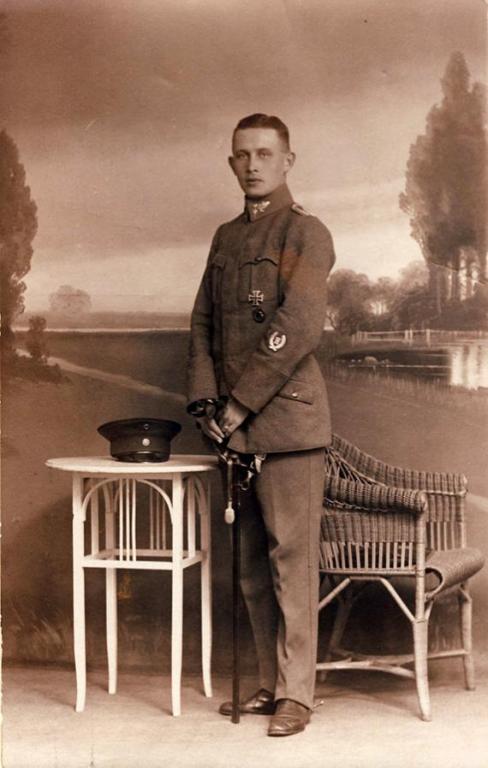


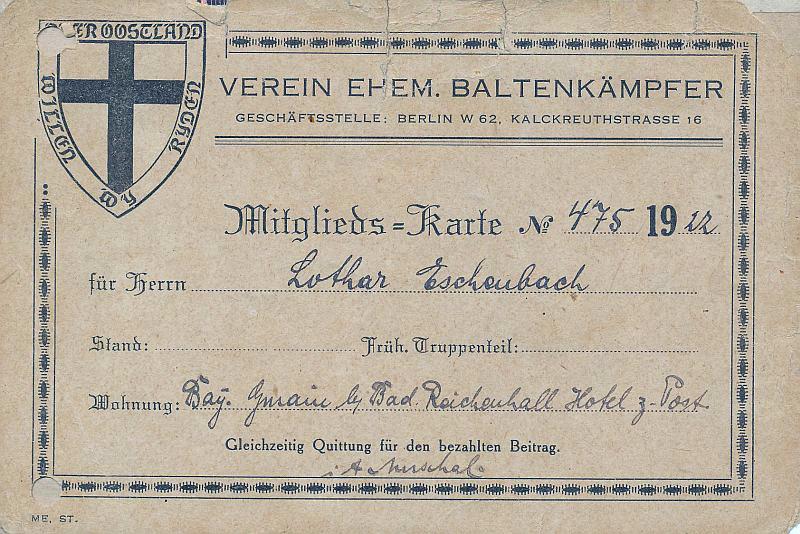
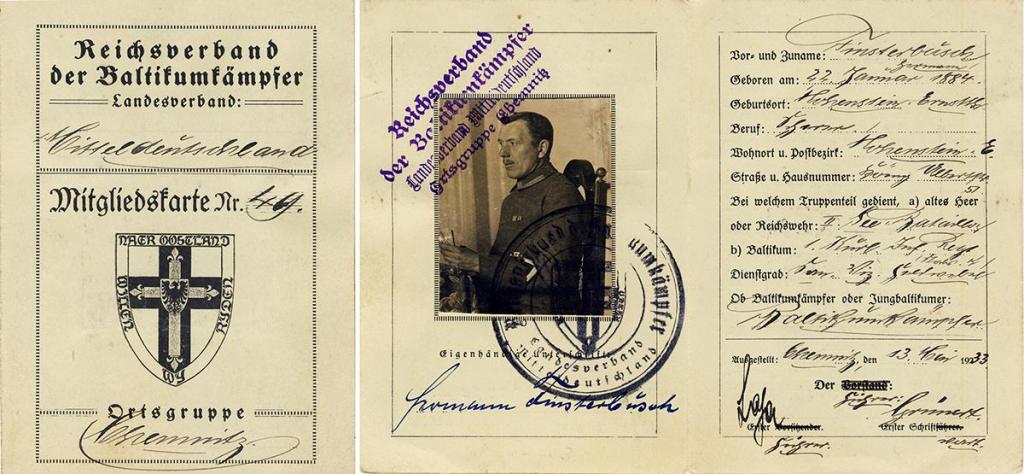
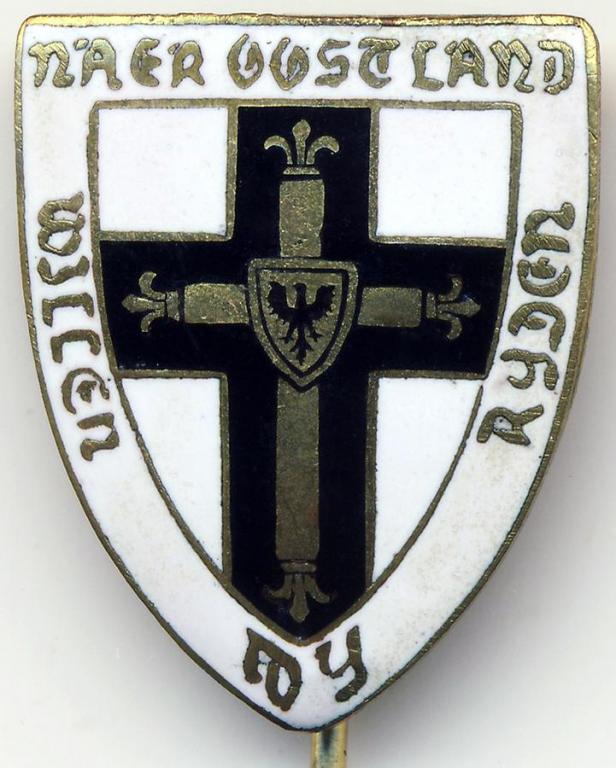


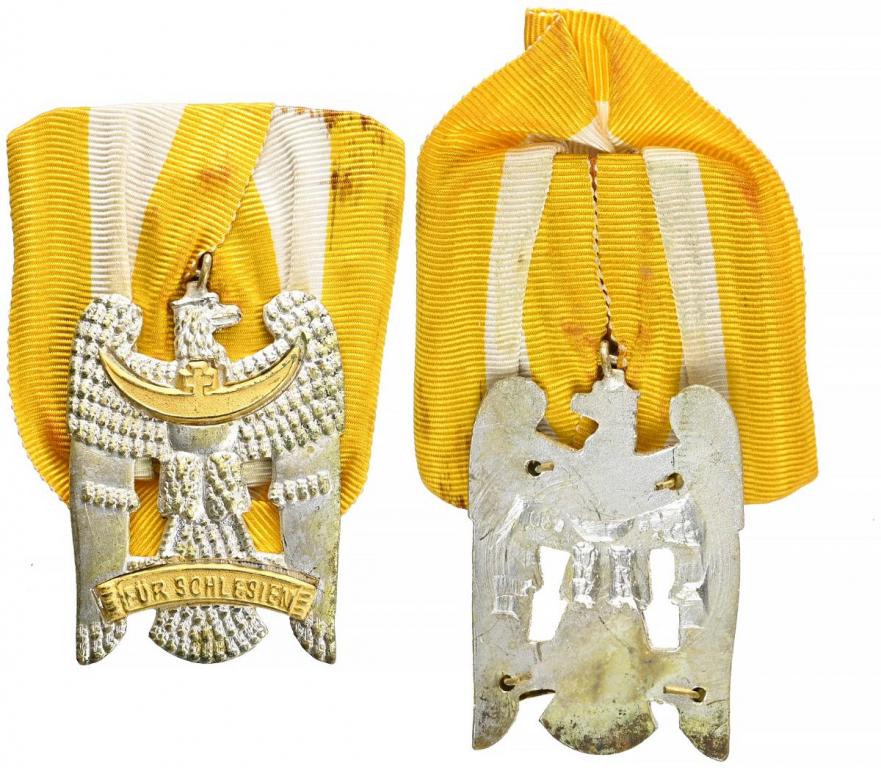
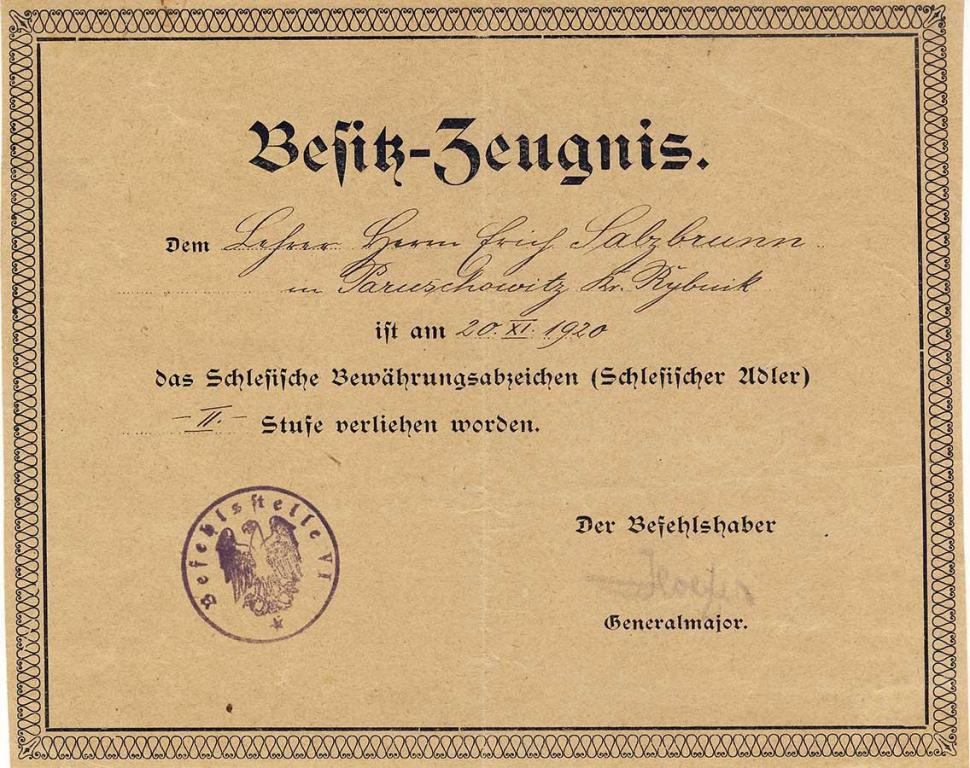

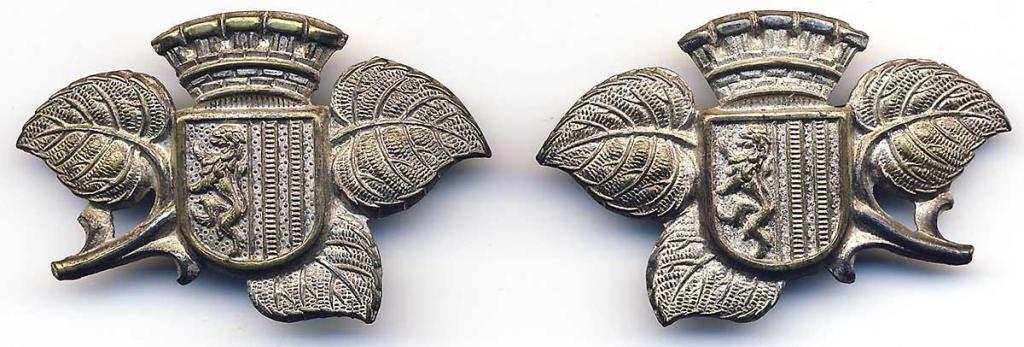
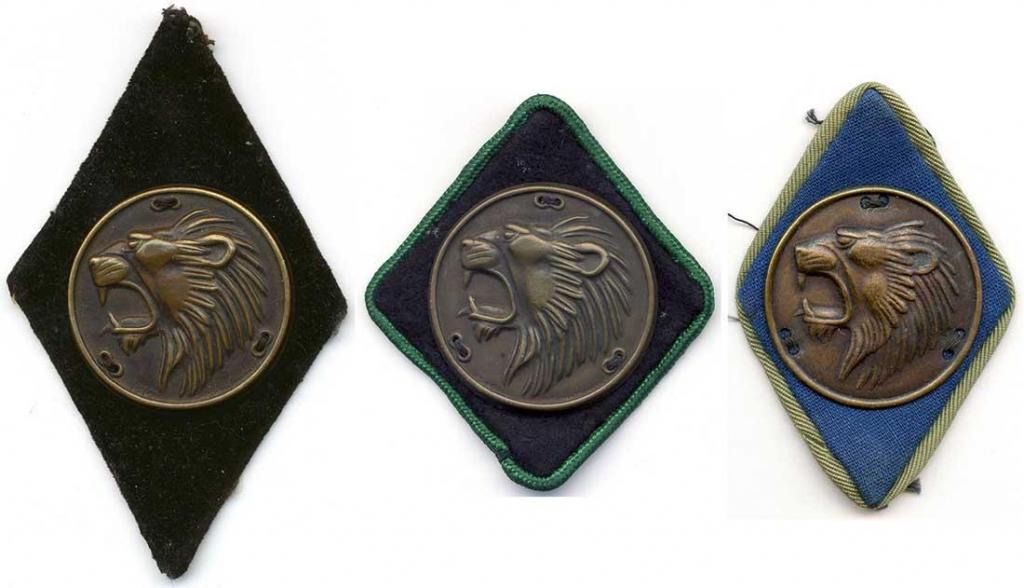
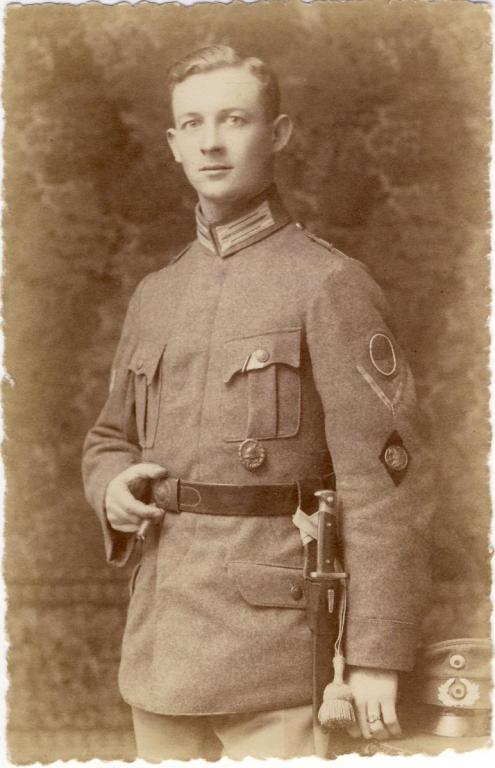
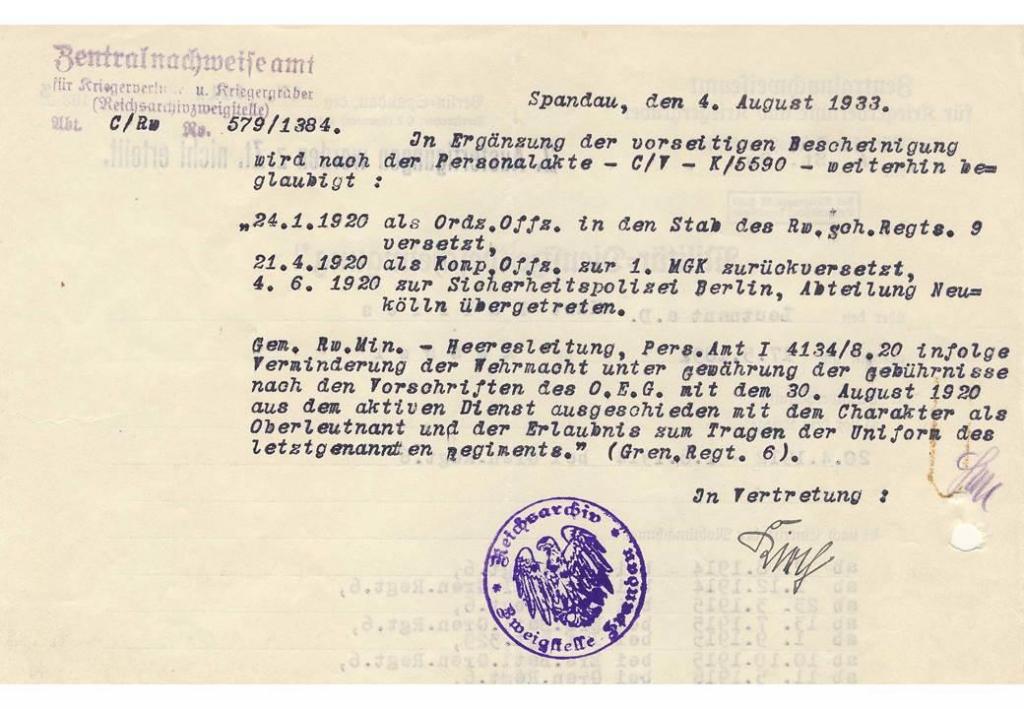
Awaloff Kreuz
in Germany: Weimar Republic & Deutsche Freikorps
Posted · Edited by bolewts58
You're actually confusing the crosses somewhat. The one you're showing here is called Der Abzeichen für Dienstgrade der russische Westarmee (Badge for All Ranks of the Russian Western Army) and was more of a unit service insignia rather than an award. It is sometimes referred to as the Avaloff Cross 3rd class, but in reality was a badge separate from the award crosses. This is the story behind this service grade cross.
By order no. 24 of March 4, 1919, Colonel Fürst Awaloff-Bermondt donated a badge in the form of a Maltese cross for the all military ranks of his volunteer troops. Colonel Potozki commander of Corps Graf Keller provided the draft of the award, which was intended to distinguish the members of his volunteer troops from other Baltic troops. The badge was based on the planned white Maltese cross of General Graf Keller's Russian White Army. However, as a sign of mourning (Count Keller was captured and shot in Kiev on December 20/21, 1918), the color was changed to black.
Here is my example of this service cross.
The cross that started the thread is called Der Awaloff-Kreuz der Freiwilligen Westrussischen
(Deutsch-Russischen) Befreiungsarmee (1919). Kreuz 2. Klasse ohne Schwerter. Here are two examples from the Peter Groch collection that are similar to the copy that started the thread. The one on the left, like the copy is a silvered cross with black enamel. The one on the right is a silvered cross with a black paint finish.